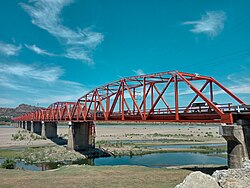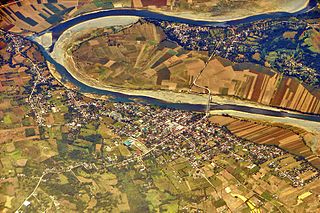
The Cagayan River, also known as the Río Grande de Cagayán, is the longest river and the largest river by discharge volume of water in the Philippines. It has a total length of approximately 505 kilometres (314 mi) and a drainage basin covering 27,753 square kilometres (10,715 sq mi). It is located in the Cagayan Valley region in northeastern part of Luzon Island and traverses the provinces of Nueva Vizcaya, Quirino, Isabela and Cagayan.

Cagayan Valley, designated as Region II, is an administrative region in the Philippines. Located in the northeastern section of Luzon, it is composed of five Philippine provinces: Batanes, Cagayan, Isabela, Nueva Vizcaya, and Quirino. The region hosts four chartered cities: Cauayan, Ilagan, Santiago, and Tuguegarao.

Cagayan, officially the Province of Cagayan, is a province in the Philippines located in the Cagayan Valley region, covering the northeastern tip of Luzon. Its capital is Tuguegarao, the largest city of that province as well as the regional center of Cagayan Valley. It is about 431 kilometres (268 mi) northwest of Manila, and includes the Babuyan Islands to the north. The province borders Ilocos Norte and Apayao to the west, and Kalinga and Isabela to the south.

The San Juanico Bridge is part of the Pan-Philippine Highway and stretches from Samar to Leyte across the San Juanico Strait in the Philippines. Its longest length is a steel girder viaduct built on reinforced concrete piers, and its main span is of an arch-shaped truss design. Constructed during the administration of President Ferdinand Marcos through Japanese Official Development Assistance loans, it has a total length of 2.16 kilometers (1.34 mi)—the third longest bridge spanning a body of seawater in the Philippines after the Panguil Bay Bridge. It was also the longest bridge in the Philippines upon its opening in 1973, surpassed in 1976 by Candaba Viaduct of North Luzon Expressway (NLEX), another bridge that connects from one province to another, connecting the provinces of Pampanga and Bulacan.

Enrile, officially the Municipality of Enrile, is a municipality in the province of Cagayan, Philippines. According to the 2020 census, it has a population of 36,705 people.
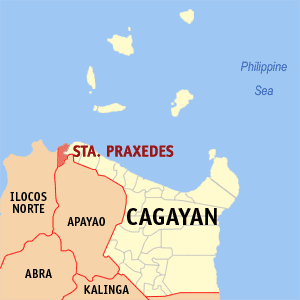
Santa Praxedes, officially the Municipality of Santa Praxedes, is a municipality in the province of Cagayan, Philippines. According to the 2020 census, it has a population of 4,434 people, making it the least populated municipality in the province.
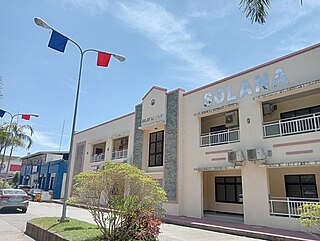
Solana, officially the Municipality of Solana, is a municipality in the province of Cagayan, Philippines. According to the 2020 census, it has a population of 88,445 people.

The Pan-Philippine Highway, also known as the Maharlika Highway, is a network of roads, expressways, bridges, and ferry services that connect the islands of Luzon, Samar, Leyte, and Mindanao in the Philippines, serving as the country's principal transport backbone. Measuring 3,379.73 kilometers (2,100.07 mi) long excluding sea routes not counted by highway milestones, it is the longest road in the Philippines that forms the country's north–south backbone component of National Route 1 (N1) of the Philippine highway network. The entire highway is designated as Asian Highway 26 (AH26) of the Asian Highway Network.

The following outline is provided as an overview of and topical guide to the Philippines:

Magat Dam is a large rock-fill dam in the island of Luzon in the Philippines. The dam is located along the Magat River, a major tributary of the Cagayan River. The construction of the dam started in 1975 and was completed in 1982. It is one of the largest dams in the Philippines. It is a multi-purpose dam which is used primarily for irrigating about 85,000 hectares of agricultural lands, flood control, and power generation through the Magat Hydroelectric Power Plant.

The Roman Catholic Archdiocese of Tuguegarao is a Latin Church metropolitan archdiocese of the Catholic Church in the Philippines. Tuguegarao is a river delta city that became center of the archdiocese in the province of Cagayan, on the island of Luzon. Its seat is located at the Saint Peter the Apostle Metropolitan Cathedral.

The Kettle Falls Bridges is the collective name for a pair of steel cantilever bridges carrying State Route 20/U.S. Route 395 and the Kettle Falls International Railway across the Columbia River at Kettle Falls, Washington. The south bridge carries motor vehicle traffic while the similar northern span is used for rail.

Sergio Lasam Utleg, is a prelate of the Roman Catholic Church in the Philippines. He is the former Archbishop of Tuguegarao in Tuguegarao, Philippines. On October 18, 2019, his resignation was accepted by Pope Francis, appointing Alaminos Bishop Ricardo Baccay as his successor.

Sargent Bridge was a Pratt through truss steel bridge that spanned the Middle Loup River near Sargent, Nebraska. In 1992, it was listed in the National Register of Historic Places, as one of the few remaining steel truss bridges constructed in Nebraska during the early 20th century. It was destroyed by flooding in 2019, and was delisted in 2020.

Tuguegarao, officially the City of Tuguegarao, is a 1st class component city and capital of the province of Cagayan, Philippines. According to the 2020 census, it has a population of 166,334 people, making it the most populous city in Cagayan Province, Cagayan Valley and Northeastern Luzon.

SM Center Tuguegarao Downtown is a shopping mall owned and operated by SM Prime Holdings, the largest mall operator in the Philippines, located in the city's business district along Luna St. cor. Mabini St., Tuguegarao City, Cagayan. Opened on October 12, 2017, it is the first SM Supermall in Cagayan, the second in Cagayan Valley and the 65th in the Philippines. Also the seventh SM Mall under the "Center" brand, it has a gross floor area of 33,301 m2 (358,450 sq ft).

The Binondo–Intramuros Bridge is a tied-arch bridge in Manila, Philippines, spanning the Pasig River. It connects Muelle de Binondo in Binondo and San Nicolas to Solana Street and Riverside Drive in Intramuros. The bridge has four lanes and exhibits a steel bowstring arch design with inclined arches. It is 680 meters (2,230 ft) long.

Santiago–Tuguegarao Road is a major national primary road in the provinces of Cagayan, Kalinga, and Isabela in the Philippines. It is a bypass road of the Pan-Philippine Highway, also known as Cagayan Valley Road, connecting to the cities of Tuguegarao and Santiago.
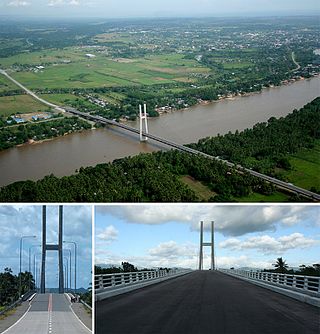
Macapagal Bridge is a steel cable-stayed bridge along Mayor Democrito D. Plaza II Avenue in Butuan, Agusan del Norte that crosses the Agusan River. It has a length of 908 m (2,979 ft), making it the second-longest bridge in Mindanao after Panguil Bay Bridge, and the third-longest cable-stayed bridge in the Philippines after the Marcelo Fernan Bridge and Cebu-Cordova Bridge.

Cagayan Valley Road is a 121.216-kilometer (75.320 mi) major highway that connects the cities and municipalities of the province of Cagayan, Philippines.
